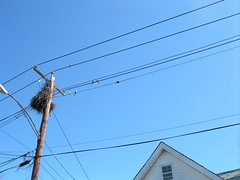Monk Parakeets

The Connecticut DEP estimates that more than 1,000 monk parakeets live in the state. Most of the birds nest in towns along the Sound. But some are moving inland.

The utility companies think they're a pain in the neck but people who live near the nests seem to like them. I side with the people.



2 Comments:
Connecticut’s United Illuminating Company in
cooperation with the U.S. Department of Agriculture
has started destroying Monk Parakeet nests and gassing
the birds living there.
The bulk of the killings are currently being
undertaken in West Haven, but will soon spread to
Milford, Stratford, Bridgeport and beyond. The
$125,000 program,
supported by both Connecticut’s
Department of Environmental Protection and
Connecticut’s Audubon Society, targets 103 nests
throughout the state.
Many of these South American birds, brought to the
United States more three decades ago, escaped and
settled along Connecticut’s coast. Their large,
intricate nests, which they often build on utility
poles are said to be a hazard to public safety. Yet
the electric company only notes two incidents where
nests were found at the site of a fire.
The USDA’s agents who kill birds and animals at
taxpayer’s expense for private industry, plan to use
Connecticut’s program as a test case. If successful,
the agency may
start using similar draconian
measures in other states.
Please call for an end to the sanctioned extermination
of these in birds that is being subsidized by
taxpayers and customers of the utility company. There
are much civilized ways of dealing with this
"problem". One method that has been used successfully
in New York and New Jersey is to wait until spring and
remove nests from utility poles before breeding
season.
Thanks for your post on this subject.
I am the Founder of EdgewaterParrots.com and I agree with anonymous.
Wild Monk Parakeets are not deserving of their notorious reputation, and there are civilized and most important, non-lethal, ways to manage populations of wild Monk Parakeets.
Attepts at eradicating the species has never been successful. The most educated and insightful utility companies, including New Jersey's PSE&G, recognize that and are utilizing humane and non-lethal methods to prevent the birds from nesting on their poles.
A successful and humane nest management strategy includes nest removals before and after the breeding season, as well as the use of orange insulating sleeves on poles where nests were removed.
Construction of alternative nesting platforms, as was done in Ct. provides the birds with a place to nest and serves to help deter them from nesting on utility poles.
Killing should never be an option, much less a first line defense, in managing wildlife populations.
For more info, see:
www.edgewaterparrots.com
www.brooklynparrots.com
www.ctquakers.com
All the best--
Alison Evans-Fragale RN, MSN, CFNP, CLNC
Founder
www.edgewaterparrots.com
Post a Comment
<< Home